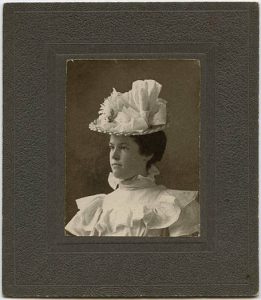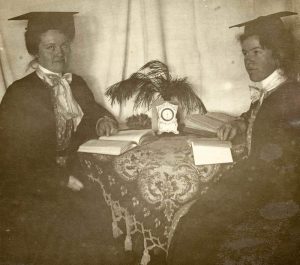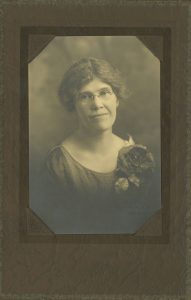(2 December 1878 – 29 July 1970)1
The University of North Carolina at Chapel Hill Herbarium (NCU) has catalogued to date 15 fungal specimens collected by Leva B. Walker. Most were collected near Lincoln, Nebraska where she spent most of her academic career. NCU’s mycological specimens, including those collected by Dr. Walker, were catalogued for the National Science Foundation funded project, the Macrofungal Collection Consortium. Other herbaria curating Dr. Walker’s fungal specimens include Cornell University (CUP), Harvard Herbaria (FH), Iowa State University (ISC), New York Botanical Garden (NY), University of California, Berkeley (UC), University of Georgia (GAM), University of Michigan (MICH), University of Nebraska (NEB; major repository), University of Washington, Seattle (WTU), and the United States National Fungal Collection (BPI).2

Leva Belle Walker was born to Levi Chamberlain and Isabel “Belle” Putman Walker on 2 December 1878 in Forest Grove, Oregon. She was educated at the Tualatin Academy and earned a B.A. in 1901 at Pacific University in Forest Grove, Oregon, an institution her paternal grandparents helped found. Leva Walker earned a masters degree from the University of Nebraska in 1908, and a Ph.D. from Cornell University in 1927.4 The title of her doctoral thesis was “The development of some Basidiomycetous fungi. A. Pluteus admirabilis, Tubaria furfuracea. B. Cyathus fascicularis, Cyathus striatus, Crucibulum vulgare,” and her thesis advisor was Dr. George F. Atkinson.9 She joined the Botany Department at the University of Nebraska as an associate professor in 1906.8
Leva Walker was a member of the Ancient and Mystic Order of the Sem. Bot. (Botanical Seminar), founded by Charles Edwin Bessey (1845-1915) at the University of Nebraska.6
An early accomplishment [of C.E. Bessey] was the founding of the Ancient and Mystic Order of the Sem. Bot. (Botanical Seminar) on October 11, 1886, which became a serious scientific society in 1891. To become a candidatus required passing written and oral tests; promotion to novitius and ordinarius might follow. Achievement of the latter entitled one to wear a chlorophyll-green scarf. Non-botanists might become honorarius members, such as zoologist, H. B. Ward and entomologists and ornithologist Lawrence Bruner… A 1907 CORNHUSKER [University of Nebraska yearbook] picture shows the members in full regalia… [and] list Roscoe Pound, Frederick Clements, A. F. Woods, Rollins A. Emerson, Elda and Leva Walker, Ernst Bessey, one of Bessey’s three sons, and Raymond J. Pool as early, very active members… Each scientific-social meeting concluded with the famous rite involving the Canis-pie (minced meat pie) eating, starting with the tip of the piece. The ritual and the early records of the society were sprinkled with Phraseology in Latin, one of the languages required for the Ph.D. degree…Detailed records ceased about 1910 and the last membership list is one for 1935.6
Leva and her sister, Elda, also a professor of botany at University of Nebraska (UNL), lived together in Lincoln, and were charter members of the Iota Chapter of Sigma Delta Epsilon, an interdisciplinary society for women in science, at UNL.7

In 1927 Dr. Leva Walker described Sphaerobolus iowensis L.B. Walker which she found “during the summer of 1919, growing on the coniferous boards of an old porch at Hunters, near Spirit Lake, Iowa.”14
According to “Great Nebraska Naturalists and Scientists” of the Archives & Special Collections of the University of Nebraska-Lincoln, Dr. Leva Walker taught classes on botany and mycology beginning in 1908. “Elda and Leva Walker retired from the University of Nebraska-Lincoln in 1946. Following [World War II], Dean C. H. Oldfather recommended the Chancellor and the Board of Regents of the University place both Elda and Leva on emeritus status starting September 1, 1946. The Dean wrote to Elda and Leva underlining his reasoning by stating “My conclusion has been reached primarily upon the grounds that the post-war reconstruction years have come upon us and the well-being of the work in Botany makes imperative the immediate rebuilding from the bottom of the staff of the Department.” Following thier forced retirement, Elda and Leva Walker took trips across the United States to visit friends and family as well as attending a few national [scientific] meetings.”13 In 1953 Leva Walker became Professor Emerita.12

Leva B. Walker’s grandparents, Elkanah (1805-1877) and Mary Richardson (1811-1897) Walker were among thirteen Christian missionaries sent to the Oregon Mission.
The Walkers and one other couple, Cushing and Myra Eells, established the mission at Tshimakain, near the present day town of Ford, Washington, to work with the Spokane Indians.
Born at North Yarmouth, Maine, in 1805, Elkanah Walker received formal education at Kimball Union Academy (Meriden, N.H.) and Bangor Theological Seminary. While a student at Bangor Theological Seminary, the American Board accepted him for missionary service. Elkanah met and became engaged to Mary Richardson, a woman who was recently rejected by the American Board for missionary service because she was single. Mary had previously received her education at Maine Wesleyan Seminary in Kent’s Hill, Maine. Her education was anything but formal, however; she was permitted to take classes, but did not receive a diploma because she was a woman. Elkanah spent most of their ten-month engagement completing his studies at Bangor Theological Seminary. They were married in March, 1838. Elkanah and Mary, both having dedicated their lives to missionary service, were quickly appointed, not to South Africa, as originally planned, but to the Oregon Mission by the American Board of Commissioners. In less than a month after their wedding, the Walkers were on their way to the Oregon territories.
The Walkers were joined on their journey by three other couples-Rev. and Mrs. Cushing Eells; Rev. and Mrs. Asa B. Smith; and Mr. and Mrs. William H. Gray — all appointees of the American Board — to the already established mission at Waiilatpu, near present-day Walla Walla, Washington. Rev. Marcus and Narcissa Whitman and Rev. Henry and Eliza Spalding had established the mission there. A single man-Andrew Rodgers-joined the party en route and accompanied them. The Walkers and the Eells established the mission at Tshimakain the following year (1838).
Both of the Walkers, but particularly Mary Richardson Walker, wrote extensively in their dairies. These dairies provide great detail into the physical, psychological and spiritual endeavors of missionary service in the primitive days of the Pacific Northwest. Much about the Walkers and the activities of the Oregon Mission have been researched and reported by Clifford M. Drury, through his books, articles and research papers.
The American Board closed Tshimakain after nine years (1838-1848), along with the entire Oregon Mission, as a result of the Whitman Massacre.
The Walkers eventually settled near Forest Grove, Oregon. Elkanah pastored a church, did itinerant preaching, and was also instrumental in starting the Tualatin Academy in Forest Grove, which later became Pacific University. The Walkers had seven children, six boys and a daughter. Their first child, Cyrus, was the first surviving white child born west of the Rockies and four other Walker children were born at Tshimakain. Elkanah died in 1877, ending a life that often suffered from a weak disposition. Mary died in 1897 in Forest Grove, having survived her husband by twenty years. She was the last surviving member of the original thirteen members of the Old Oregon Mission.
The impact of the Walkers and the other members of the Oregon Mission was significant, but not immediate. Although they could not count a single convert from the work at Tshimakain, an active congregation was later established among the Spokane Indians. Elkanah wrote a primer in the Spokane Indian language, “Etshiit thlu Sitskai thlu Siais thlu Sitskaisitlinish”, which was printed in 1842 on the Lapwai Mission press (Washington State University MASC holds a facsimile copy). In addition, the establishment of the Old Oregon Mission sites provided an example to the nation that settlement of the Oregon Territories was not only possible, but also feasible.
“The Record” (Pullman, Wash., Friends of the Library, Washington State University), states that the Walker library “is believed to have been the first collection of books in the present Inland Empire.” If not the first, the Walker library was surely one of the first two or three book collections to enter the Pacific Northwest, according to historian Clifford M. Drury. For Drury’s summary of the Walker library, see his article in the Oregon Historical Quarterly, Vol. 42 (1941), pp. 169-171. 3
Leva’s father was Elkanah and Mary Walker’s next to last child, Levi C. (1850-1909).2 Levi and his wife, Belle, were teachers at Forest Grove Indian Training School, one of the first off-reservation boarding schools for Native Americans in the country.10 Leva and her sister, Elda Rena Walker (1877-1971), donated their family library of books to the State College of Washington in 1939. “The Walker Library” and the Walker family papers are curated by Washington State University in Pullman, Washington. Pacific University also has Walker family documents, including the papers of sisters Leva B. and Elda R. Walker; these are in the process of being cataloged.10
Leva B. Walker’s uncle, Cyrus Walker was an employee of the Warm Springs Indian Agency in Oregon. Pacific University curates a letter he wrote to his wife, Mary Wheeler Walker. “On the second page of the letter, he describes the fate of the children who had been send from Warm Springs [Oregon] to the Forest Grove Indian School and its successor, Chemawa Indian School, between 1880-1890. “I have been at work making out a list of all the Indian children that have been sent to Forest Grove and Chemawa, when they went, when returned, for what cause, when died of those dead, present place of residence & health.” The list itself is not attached, but he does provide a compilation of the figures, e.g. “Died 22. Graduated 8.” [Cyrus Walker] says that of the 35 who were originally sent to the Forest Grove Indian school campus, 14 either died at school or died soon after being sent home. Overall, a third of the children who had been sent to Forest Grove and Chemawa up through 1890 died at the school or soon after being sent home.”15
=====
Leva Walker died at age 91 in Lincoln, Nebraska. Her sister, Elda, died the following June.13 Both are buried with their parents in Forest View Cemetery in Forest Grove, Washington.5
Publications: (incomplete list)
Walker, Leva B. (1940) Development of Gasterella lutophila. Mycologia 32(1): 31-42.
(1935) Gasterella, A New Uniloculate Gasteromycete, Mycologia, 27:6, 573-579, DOI: 10.1080/00275514.1935.12017101
Walker, Leva B. (1935) Studies on Ascoidea rubescens: II. Cytological observations. Mycologia 27(2): 102-127.
Walker, Leva B. (1931) Studies on Ascoidea rubescens: I. History and development. Mycologia 23(1): 51-76.
(1925) Relation of Glycogen to Spore-Ejection, Mycologia, 17:4, 154-159, DOI: 10.1080/00275514.1925.12020467
Walker, Leva B. (1927) Development and mechanism of discharge in Sphaerobolus iowensis n. sp. and S. stellatus Tode. Journ. Elisha Mitchell Scientific Society 42(3): 151-178.
Walker, Leva B. (1927) The development of some Basidiomycetous fungi. A. Pluteus admirabilis, Tubaria furfuracea. B. Cyathus fascicularis, Cyathus striatus, Crucibulum vulgare. Doctoral Thesis, Cornell University, Ithaca, New York.
Walker, Leva B. (1923) Some observations on the development of Endogone malleola Hark. Mycologia 15(6): 245-257.
Walker, L. B. (1922). The forceful ejection of the glebal mass by Sphaerobolus. Proc. Nebr. Acad, 10, 23-25.
Walker, Leva B. (1920) Biology and culture of the higher fungi. Bot. Gazette 69(2): 188-189.
Walker, Leva B. (1920) Development of Cyathus fascucularis, C. striatus, and Crucibulum vulgare. Bot. Gazette 70(1): 1-24.
Walker, Leva B. (1919) Development of Pluteus admirabilis and Tubaria furfuracea. Bot. Gazette 68(1) 1-21.
Walker, Leva B. (1913) The Black Moulds (Muscoraceae). Trans. Of the Am. Microscopical Soc. 32(2): 113-126.
Walker, L. B. (1908). A new form of Sphaeropsis on apples. Ann. Rep. Nebraska Exp. Sta, 20, 34-44
SOURCES:
1. Photograph of headstone “Leva B. Walker.” http://orgenweb.org/washington/Washington/Cem/Forest_View_Forest_Grove/W/Walker,%20Leva%20B..JPG accessed on 20 January 2014.
2. MyCoPortal . 2023. http://www.mycoportal.org/portal/index.php. Accessed on July 19.
3. Cache from 20 December 2013 16:53:51 GMT of http://webcache.googleusercontent.com/search?q=cache:XaRIyd0xJJMJ:griffin.wsu.edu/masc/walkerlibrarydescription.html+&cd=9&hl=en&ct=clnk&gl=us
4. http://www.usgennet.org/usa/ne/topic/resources/OLLibrary/who1940/co/Lancaster/lancstrq.htm accessed on 20 January 2014.
5. http://orgenweb.org/washington/Washington/Cem/Forest_View_Forest_Grove/W/ accessed on 20 January 2014.
6. Holck, Harold G.O. (1973) Niches of Nebraska Scientists. Charles Edwin Bessey (1845-1015). Transactions of the Nebraska Academy of Sciences & Affiliated Societies. Paper 376.
7. http://unllib.unl.edu/archon/?p=creators/creator&id=563 accessed on 20 January 2014.
8. Benjamin, Richard K., ed. (1962, June) Mycological Society of America Newsletter 13(1): 17. http://msafungi.org/wp-content/uploads/Inoculum/13(1).pdf accessed on 20 January 2014.
9. “Faculty Notes.” The University Journal (Alumni Edition) 12(4): 17. Lincoln, Nebraska: University of Nebraska Alumni Association. 1916.
10. Pers. comm. Eva Guggemos, M.A., M.L.S., Archivist, Pacific University Library, email to C.A. McCormick 2014 January 21.
11. Find a Grave, database and images (https://www.findagrave.com/memorial/51308166/leva-belle-walker: accessed 20 July 2023), memorial page for Dr Leva Belle Walker (2 Dec 1878–29 Jul 1970), Find a Grave Memorial ID 51308166, citing Forest View Cemetery, Forest Grove, Washington County, Oregon, USA; Maintained by Tracy Turner (contributor 46815350).
12. Leva B. Walker. Great Nebraska Naturalists and Scientists. Archives & Special Collections, University of Nebraska-Lincoln. https://sandhillsarchive.unl.edu/project/leva-b-walker/ accessed 20 July 1023.
13. Skinner, Colton. 2022. Elda R. Walker. Great Nebraska Naturalists and Scientists. Archives & Special Collections, University of Nebraska-Lincoln. https://sandhillsarchive.unl.edu/project/elda-walker/ accessed on 10 July 2023.
14. Walker, Leva B. (1927) Development and mechanism of discharge in Sphaerobolus iowensis n. sp. and S. stellatus Tode. Journ. Elisha Mitchell Scientific Society 42(3): 151-178.
15. Walker, Cyrus Hamlin (undated) “Letter to Mary Wheeler Walker on Warm Springs students who were sent to and/or died at the Forest Grove Indian School and Chemawa”. Identifier: PUA_MS102_1890_09_12.pdf Collection: The Forest Grove Indian Training School Cyrus Walker Papers. Pacific University.
Special thanks to Eva Guggemos, M.A., M.L.S., Archivist, Pacific University Library for Walker family information & photographs of Leva and Elda Walker.
